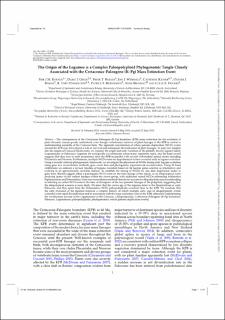| dc.description.abstract | The consequences of the Cretaceous–Paleogene (K–Pg) boundary (KPB) mass extinction for the evolution of plant diversity remain poorly understood, even though evolutionary turnover of plant lineages at the KPB is central to understanding assembly of the Cenozoic biota. The apparent concentration of whole genome duplication (WGD) events around the KPB may have played a role in survival and subsequent diversification of plant lineages. To gain new insights into the origins of Cenozoic biodiversity, we examine the origin and early evolution of the globally diverse legume family (Leguminosae or Fabaceae). Legumes are ecologically (co-)dominant across many vegetation types, and the fossil record suggests that they rose to such prominence after the KPB in parallel with several well-studied animal clades including Placentalia and Neoaves. Furthermore, multiple WGD events are hypothesized to have occurred early in legume evolution. Using a recently inferred phylogenomic framework, we investigate the placement of WGDs during early legume evolution using gene tree reconciliation methods, gene count data and phylogenetic supernetwork reconstruction. Using 20 fossil calibrations we estimate a revised timeline of legume evolution based on 36 nuclear genes selected as informative and evolving in an approximately clock-like fashion. To establish the timing of WGDs we also date duplication nodes in gene trees. Results suggest either a pan-legume WGD event on the stem lineage of the family, or an allopolyploid event involving (some of) the earliest lineages within the crown group, with additional nested WGDs subtending subfamilies Papilionoideae and Detarioideae. Gene tree reconciliation methods that do not account for allopolyploidy may be misleading in inferring an earlier WGD event at the time of divergence of the two parental lineages of the polyploid, suggesting that the allopolyploid scenario is more likely. We show that the crown age of the legumes dates to the Maastrichtian or early Paleocene and that, apart from the Detarioideae WGD, paleopolyploidy occurred close to the KPB. We conclude that the early evolution of the legumes followed a complex history, in which multiple auto- and/or allopolyploidy events coincided with rapid diversification and in association with the mass extinction event at the KPB, ultimately underpinning the evolutionary success of the Leguminosae in the Cenozoic. [Allopolyploidy; Cretaceous–Paleogene (K–Pg) boundary; Fabaceae, Leguminosae; paleopolyploidy; phylogenomics; whole genome duplication events] | en_US |

